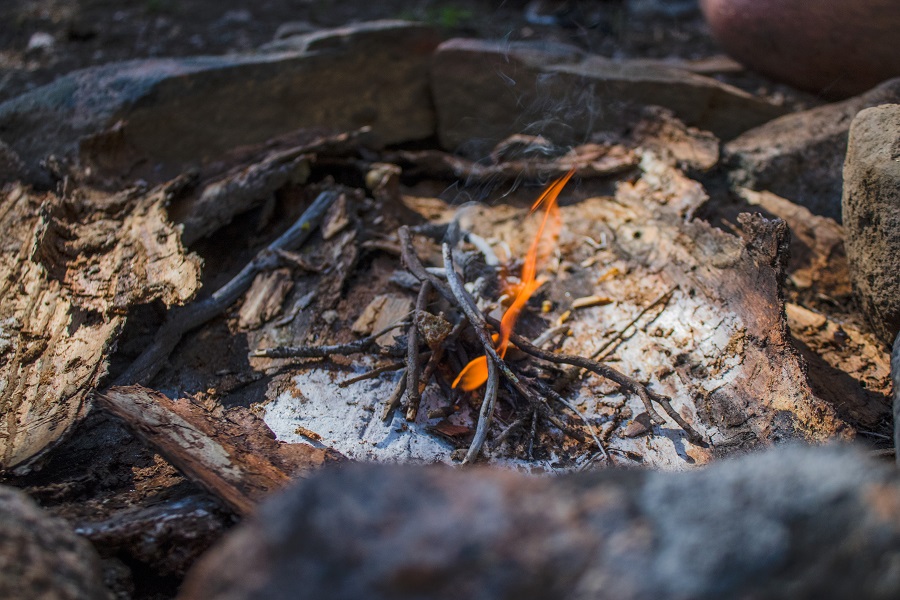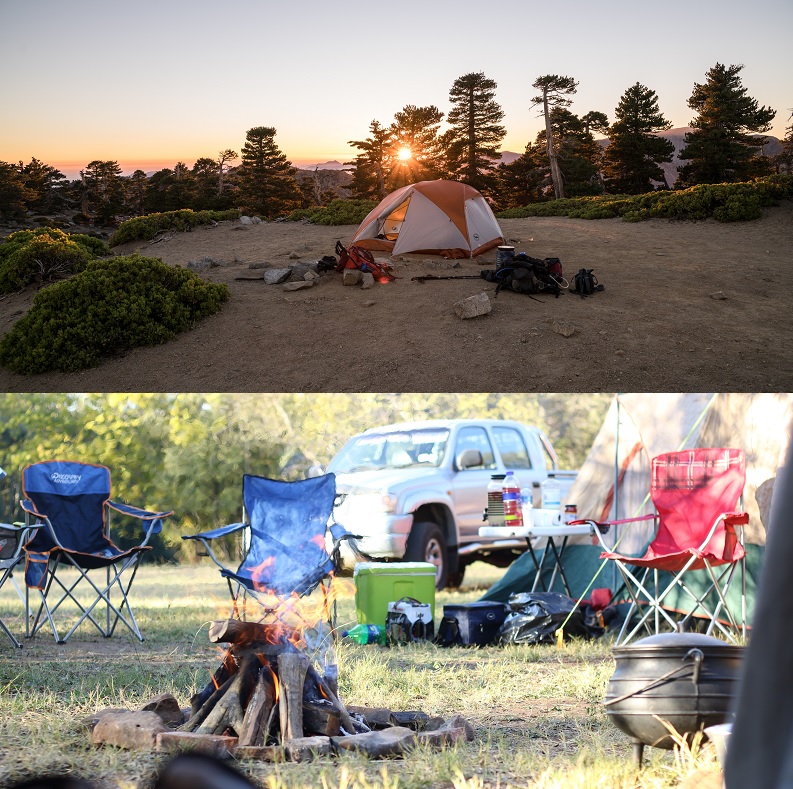Having a fire is essential for an enjoyable camping experience. It is used for heat and for cooking but having a fire also give a strange feeling of security. You know you will be ok once your fire is lit.
Knowing how to build a fire pit while camping is one of the most important things to know. Along with water and shelter, fire is essential for survival. The purpose of a fire pit is to prevent the spread of fire to unwanted areas of the camp and to shield the fire from the wind.
Essentially a fire pit is a hole in the ground where you can place your fire. The first thing to do is it clear the surrounding area from debris. Any old branches, leaves or pine needs to be removed from the area. You should be down to bare earth before you even dig a fire pit. The size of the hole should be the size of your intended fire. A camping shovel or even the back of your peg hammer can be used to dig. Otherwise use an old branch to soften the ground and then scrap out the dirt by hand. Three to five inches will do for normal conditions but if it is windy you will want to go a little deeper. Once the hole is dug, place a ring of stone around the hole. This will add to the depth of hole and provide support for your cooking gear. In areas where you cannot dig, a ring of stones will also work. There are lots of tricks I’ve learned through the years which I will discuss below.
Camping ground regulations
It’s a good idea to call ahead. Find you out if the camping ground or state/national park will allow fires. Even if you have been there before there could be a temporary fire ban due to recent dry weather.
Never light fires in very dry areas. They could cause wildfires that could burn for weeks. Also, find out the size of the fire that you are allowed. I normally keep mine around one and a half to two foot wide. Some people seem to think a massive fire is the way to go. I can’t see the point in having a large fire. They become too hot to stand near and it uses up a lot of fuel.
Find out if you are allowed to forage for wood for your fire. Most camping grounds and state/national parks don’t allow this so you will have to bring your own. It is important to buy your sticks near to where you will be burning. If you bring sticks from far away, they could have foreign bugs and they may disrupt the ecosystem of the place you’re camping. Your camping ground may insist that you buy the sticks from them.
Make sure your camp and all other flammable gear is at least 10 ft for the fire. It is also a good idea to make sure your tent is upwind, unless you like a tent full of smoke.
If you intend to drink alcohol then this is also a good time to find out if your allowed. And if you intend to use fire accelerants such as lighter fluid then you will also need permission. Some parks prohibit the use of chemicals.
Building a fire pit
As mentioned above, clear the surrounding area for all debris. I normally have a small rake that I can use if I’m camping near my car, otherwise I use the side of my boot. Make sure your there is no overhead branches that could catch fire.
If your camping on grass then you will want to remove the sod. Cut a circle into the grass. Then try to peel the sod up in one go, or in as little pieces as possible. Keep them aside. You can replace the sod when the fire is out and no one will know you were there.
Dig the hole either with a camping shovel or the back of your peg hammer. A bit of a branch will also work. The hole should be dish shaped. Deepest in the middle and rising at the edges. Line the hole with sand if you can but this is not essential.
Line the hole with a ring of stones. This will further prevent the spread of fire and will act as a support for cooking utensils. Don’t use stones from a river. There could be trapped water within the stone. When you heat these stones the water inside will expand and can actually make the stone explode.
If you’re camping on grass, make sure you remove enough sod so that the stones will fit into the hole as well. You don’t want the fire getting to the grass.
That should be you all set. On to safely light the fire.
Lighting the fire
So now that you have the firepit ready it’s now time to light the fire. Collect firewood before you start. You don’t want to go to the bother of lighting a fire only to have it go out while you’re off collecting more firewood.
Start by lighting dry grass of small twigs to get the fire going. As the fire gets bigger gradually add larger twigs until it is big enough to add larger branches. Don’t rush this. If you put too much sticks on too fast you will starve the flames from oxygen then the fire will go out.
How much firewood do you need?
Unfortunately there is no one answer to this. The short answer is to buy two bags of sticks per night. This should be enough for a moderate size fire that will last about 6 hours.
There are several factors that will influence the amount of firewood needed.
Type of wood
Hardwoods such as ash, birch, beech, oak or maple will burn for longer than softwood because they are denser. Softwood include pine spruce and fir. Softwoods are good for starting the fire while hardwoods are good for keeping it lit for longer.
Thickness
The bigger the log the longer it will last. A fire will burn narrow stick much faster.
Dryness of the wood
You don’t want your wood to be wet but if it is too dry then it will burn up very fast. Wet or damp wood will smoke a lot more than dry wood.
The size of the fire
Obviously, if you want a big fire you are going to need more wood. Your fire should be the big enough to keep you warm and /or the cook your food. Any bigger is a waste.
The duration of your camp
If you are going to be camping for a few days then you are going to need more firewood. You don’t have to buy or collect it all on the first day but always make sure you have enough on the fire while you go off to get more, while you leave someone to watch the fire.
Putting out the fire.
A campfire should never be left unattended. Forest fires start by neglecting your fire. If you light a fire then you are responsible for it. Before leaving your camp make sure it is completely extinguished.
First pour water over your fire to extinguish the flames. You really want to drown it. You don’t want to just put the flames out, you want to cool the sticks and stone around the fire. Mix the ashes and burnt sticks around with a stick to make sure all areas a doused in water.
Before you leave camp feel to fire pit. Feel any burnt sticks and the stones around the fire. Feel under the stones as well. If there is anywhere that is too hot to touch then it is possible to reignite after you leave. After you’re happy that everything is cool enough, pour another bucket of water over it, just to be sure.
No water? Well you can shovel dirt on top of the fire to put it out. This process takes longer and it is not as foolproof but it is better than leaving a lit campfire. Just make sure that you aren’t shovelling anything that can burn onto the fire or you will just keep burning. It has to be bare earth or sand.
Once the flames are out for a while break up the fire to make sure there is nothing burning underneath. When your happy that everything is cool enough so it won’t reignite, shovel more earth on top.
I have created other posts that relate closely to this topic which are;
If you want to know how to light a fire in even more detail then click here
Find out how to light a fire without matches or a lighter here
You can learn how to cook on an open fire here.
If you have found this article helpful then please remember to share by clicking on one of the buttons below. It will help others find this article too.



